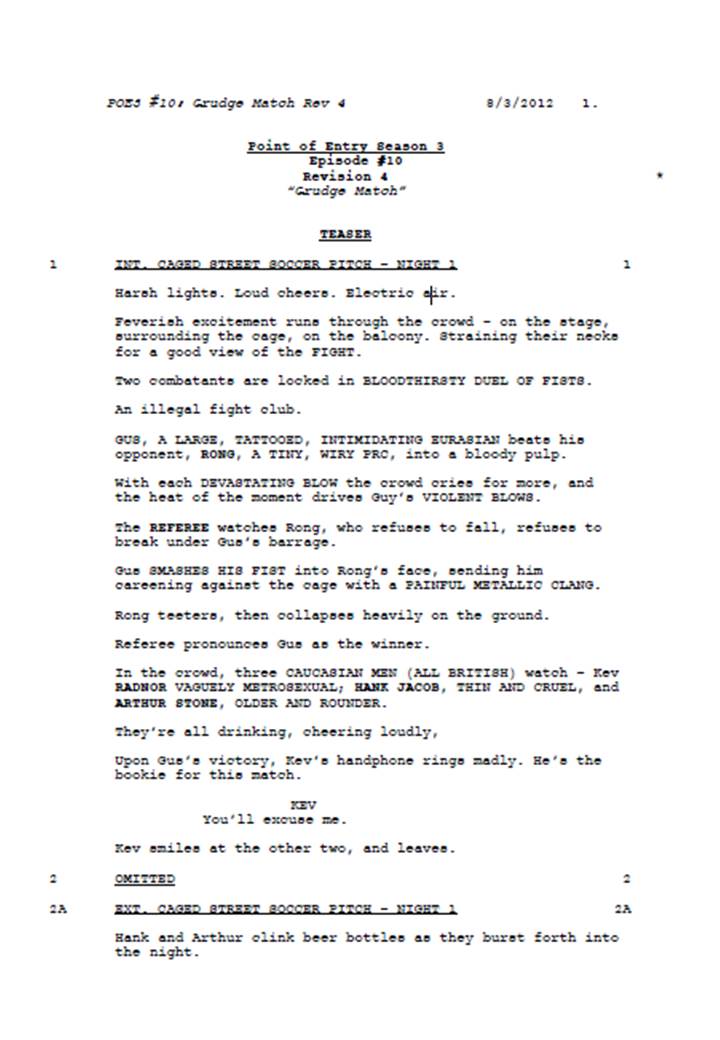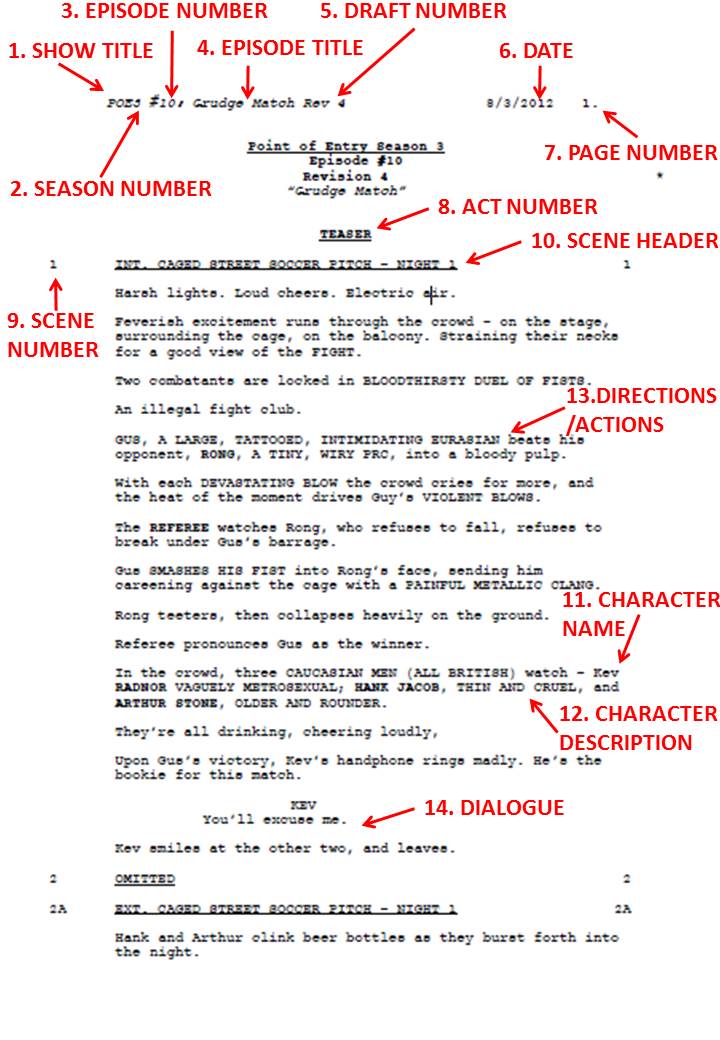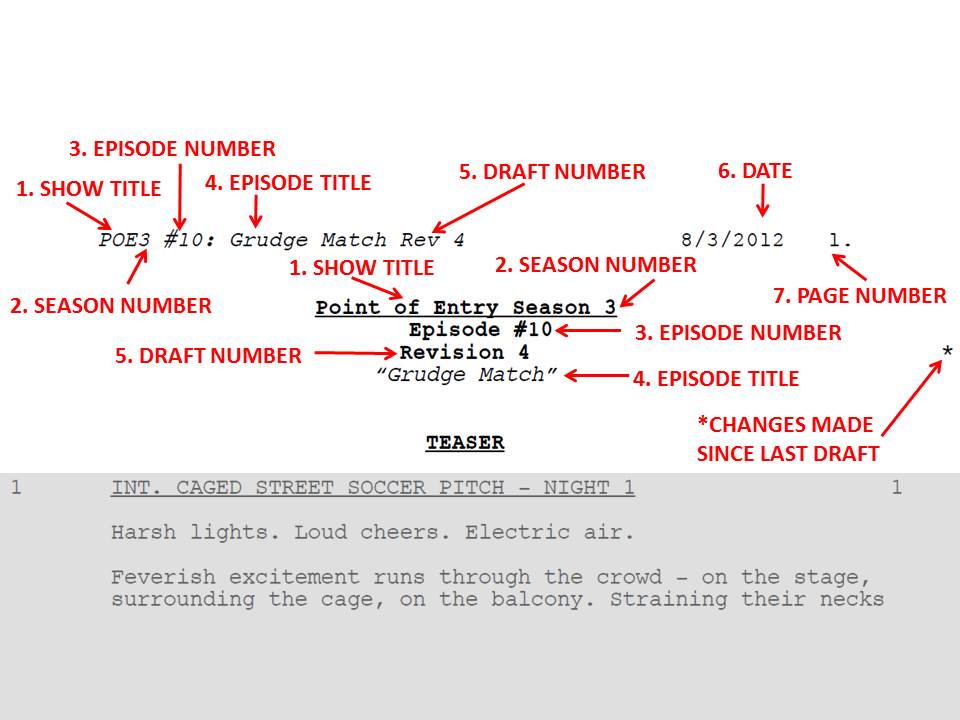Writing a script is a lot more complicated than writing a story. At least with a story, you can use different formatting techniques to tell your story, and you only have one person to please – your audience (and perhaps your editor).
With a script, you not only have to convey you whole story to everyone who’s involved in the production, but you have to point out exact details such as time of day, which location it takes place in, and what props for needed (this is not an exhaustive list, but you get the picture). You need to give a clear idea of what’s needed in your story, because you depend on hundreds of people to execute that vision, and they all need to know what you want to be able to execute it properly.
That’s why script formatting is important. It makes sure everyone is on the same page (this joke never gets old, I swear) and it helps with pre-production, since everyone knows where to look for the information that’s important to them. So here’s the format of a script.

This is a page off a sample script to start with. Can you identify all the components of a script? Do you know why random numbers and information is inserted in there?

As you can see, on the first page alone, there are 14 critical pieces of information you need to have. They don’t necessarily have to be in this particular order, but they must all be there, and I find this is the neatest way to organise the script. Let’s take a look at the components that make up the header and title of the script first.

Header Components
All the information here should be on EVERY PAGE of the script, barring the cover page. Why? This is in case anybody loses a page or you need to specifically reference something. Things get lost easily on set, and with so many people working on the same thing, everyone needs to be able to quickly identify what you’re talking about. You don’t want everyone to be looking at page 6 of Episode 8 while you’re looking at page 6 of Episode 10. Things like that.
Besides the header, there’s also the title of the script (the four liner before the Teaser), which duplicates some of the information. It may look redundant, but it’s a very useful of way of checking to see if the bundle of scripts you’re giving out is the right episode, and it allows you to spell out everything that might not fit in the header.
Finally your header should only be one line – so don’t be afraid to use acronyms where needed.
1. Show Title: You need to know you’re working on the right show. In the header it can be abbreviated (in this case, Point of Entry is POE) but if you use titles, spell it out. That way people can double check the title of the show. In any case, this information should also be on the Cover Page (which is another post for another day).
2. Season Number: Again, you need to know you’re working on the right season. This is to prevent any silly mistakes. You don’t want to schedule locations and shoots for an episode that was two seasons ago, since not all crew members commit every episode to memory to mind.
3. Episode Number: This is particularly critical as production-wise, it allows them to quickly identify the episode. Story wise, it helps you organise season-wide events – what’s happening with this character at this point in the story? Also, for some drama serials, there are no episode titles – so the only way to differentiate the episodes is by the episode number.
4. Episode Title: As with the episode number, it’s to identify what episode you’re working on. Sometimes episode titles aren’t displayed in the episode proper, and are only found on accompanying materials. But you’d still want an episode title because that’s part of the fun of being a scriptwriter, isn’t it? It’s akin to giving your baby a name.
5. Draft Number: Critical. You want everyone working on the latest draft as much as possible. Especially if you’ve made drastic changes between drafts. Generally, the naming conventions goes like this – Draft 1, Draft 2, Draft 3… Final Draft. There shouldn’t be major location or character changes after the Final Draft as the story should be pretty finalised by then (the pages will be locked in place). But sometimes you’ll need to tweak a bit of dialogue here and there, and so the naming convention goes – Final Draft, Revision 1, Revision, Revision 3…
6. Date: For all manner of reasons, if not to double check that you have the latest draft, you’ll need the date as well. Final Draft automatically generates the date that the PDF is created, so there’s no cheating there.
7. Page Number: Again, for easy referencing. Have you discussed a script over the phone, or in a 10-person meeting? Page numbers help immensely. Remember how under Draft Number, I mentioned how your Final Draft will have the pages locked in place? If you make any changes that make a page run longer than one page, Final Draft will generate a B version of the page, so your script will run like this – Page 2, Page 2B, Page 3, Page 4 – and the information that was previously on Page 3 won’t get pushed all over the place and affect the other scripts. Again, this is if you only make amendments to one page in your revision. You don’t want to kill so many trees by issuing an entire script again, so it’s possible to just issue the pages that were amended (and remember, your header will indicate a different draft number so you’ll know those are the amended pages).
* Changes: In Final Draft, you’ll sometimes see * along the margins. This indicates lines that have been changed after the Final Draft (and after the pages have been locked). It’s a quick and easy shorthand to see what has been changed, if you’re in a rush.
That’s it for Components of a Script, Part 1! Check in next Tuesday where I go through the rest of a script and what each section means in Components of a Script, Part 2.
Leave a Reply